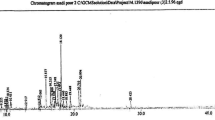Abstract
Two methods including essential oil extraction and preparation of herbal extract were used to determine the compositions of the Thymus pubescens (Boiss.et Kotschy ex Celak). The former was carried out though maceration by two solvents and the latter is done in a Clevenger apparatus using water. Gas chromatograph (GC) coupled to a mass spectrometer (MS) system was used to determine the composition of samples. The results showed that the major compositions of the aqueous extraction of essential oil are Alpha-pinene (0.9%), Borneol (10.36%), Thymol (28.01%), Trans-caryophylene (27.14%), delta-cadinene (4.30%), while for the ethanol extraction are alpha-pinene (10.71%), trans-caryophylene (73.42%), phenol (7.3%) and for acetone extraction are alpha-pinene (18.17%), cineole (11.23%), gamma-terpinene (7.26%), borneol (6.1%), thymol (9.41%), carvacrol (0.56%), and trans-caryophylene (29.62%).




Similar content being viewed by others
References
Al Maqtari A, Alghalibi SM, Alhamzy EH (2011) Chemical composition and in vitro activity of essential oil of Thymus vulgaris from Yemen. Turk J Biochem 36(4):342–349
Amini M, Safaie N, Salmani MJ, Shams-Bakhsh M (2012) Antifungal activity of three medicinal plant essential oils against some phytopathogenicfungi. Trakia J Sci 10(1):1–8
Amirghofran Z, Ahmadi H, Karimi MH (2012) Immunomodulatory activity of the water extract of Thymus vulgaris, Thymus daenensis and Zatariamultiflora on dendritic cells and T cells responses. J Immunoassay Immunochem 33(4):388–402
Bagamboula CF, Uyttendaele M, Debevere J (2004) Inhibitory effect of thyme and basil essential oils, carvacrol, thymol, estragol, linalool and p-cymene towards Shigellasonnei and S.flexneri. Food Microbiol 21:32–42
Baghaleian K, NaghdiBadi H (2000) Volatile oil crops; their biology, biochemistry and production. Andarz Publication, p 248
Berrington D, Lall N (2012) Anticancer activity of certain herbs and spices on the cervical epithelial carcinoma (HeLa) cell line. Evid Based Complement Altern Med 2012:1–11
Burt S (2004) Essential oils: their antimicrobial properties and potential application in foods-A review. Int J Food Microbiol 94:223–253
Dormana HJD, Peltoketo A, Hiltunen R, Tikkanen MJ (2003) Characterisation of the antioxidant properties of de-odourised aqueous extactsfromselectedlamiaceae herbs. Food Chem 83:255–262
Grigore A, Paraschiv I, Colceru-Mihul S, Bubueanu C, Draghici E, Ichim M (2010) Chemical composition and antioxidant activity of Thymus vulgaris L. volatile oil obtained by two different methods. Romanian. Biotechnol Lett 15(4):5436–5443
Kaledaite R, Bernatonieneb B, Majiene D, Dvorackova K, Masteikova R, Muselik J, Kalveniene Z, Liobikas J, Savickas A (2011) Investigation of antiradical activity of Salvia officinalis L., Urticadioica L., and Thymus vulgaris L. extracts as potential candidates for a complex therapeutic preparation. J Med Plants Res 5(25):6090–6096
Lee SH, Chang KS, Su MI, Huang YS, Jang HD (2007) Effects of some Chinese medicinal plant extracts on five different fungi. Food Control 18:1547–1554
Mahboubi M, GhazianBidgoli F (2010) Antistaphylococcal activity of Zataria multiflora essential oil and its synergy with vancomycin. Phytomedicine 17:548–550
Marghitas L, Dezmirean D, Chirila F, Fit N, Bobis O (2011) Antibacterial activity of different plant extracts and phenolic phytochemicals tested on Paenibacillus larvae bacteria. Anim Sci Biotechnol 44(2):94–99
Meister A, Bernhardt G, Christoffel V, Buschauer A (1999) Antispasmodic activity of Thymus vulgaris extract on the isolated guinea-pig trachea: discrimination between drug and ethanol effects. PlantaMedica 65(6):512–516
Misaghi A, Basti AA (2007) Effect of zataria multiflora Boiss essential oil nisin on Bacillus cereus ATCC 11778. Food Control 18:1043–1049
Nilforoushzadeha MA, Shirani-Bidabadia L, Zolfaghari-Baghbaderania A, Saberia S, Siadata AH, Mahmoudib M (2008) Comparison of Thymus vulgaris (Thyme), Achilleamillefolium (Yarrow) and propolis hydro-alcoholic extracts versus systemic glucantime in the treatment of cutaneous leishmaniasis in balb/c mice. J Vector Borne Dis 45:301–306
Omidbaigi R (2005) Production and processing of medicinal plants. Astan Godesa Razavei Publication, vol 1, Mashhad, Iran, p 346
Ozkan G, Simsek B, Kuleasan H (2007) Antioxidant activities of Saturejacilicica essential oil in butter and in vitro. J Food Eng 79:1391–1396
Poralijan V, Shokuhi Rad A (2016) Extraction of Eugenol from carnation: a quantitative and qualitative analysis by aqueous and ethanolic solvents. J Essent Oil Bear Pl 19(6):1495–1502
Ruberto G, Baratta MMT (2000) Antioxidant activityof selected essential oil components in two lipid model systems. Food Chem 69:167–171
Shaffiee A, Javidan K (1997) Composition of essential oil of Zatariamultiflora. Plant Med 63:371–372
Sharififar F, Moshafi MH, Mansouri SH, Khodashenas M, Khoshnoodi M (2007) In vitro evaluation of antibacterial and antioxidant activities of the essential oil and methanol extract of endemic Zataria multiflora Boiss. Food Control 18:800–805
Skandamis P, Koutsoumanis K, Fasseas K, Nychass GE (2001) Inhibtion of ovegano essential and EDTA on E coli O157:H7. Ital J Food Sci 13:55–65
Wettasinghe M, Shahidi F (1999) Antioxidant and free radical-scavenging properties of ethanolic extracts of defatted borage (Boragoofficinalis L.) seeds. J Food Chem 67:399–414
Acknowledgements
We would like to thank the Qaemshahr Branch, Islamic Azad University, Iran for its financial support.
Author information
Authors and Affiliations
Corresponding author
Rights and permissions
About this article
Cite this article
Mohseni, S., Rad, A.S. Determination of Compositions of Thymus Pubescens; the Comparison of Different Solvents towards Extraction. Iran J Sci Technol Trans Sci 42, 1923–1928 (2018). https://doi.org/10.1007/s40995-017-0159-3
Received:
Accepted:
Published:
Issue Date:
DOI: https://doi.org/10.1007/s40995-017-0159-3




